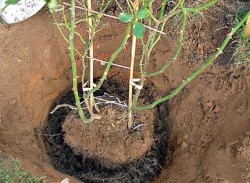
Planting roses in autumn
In autumn, roses are planted from mid-September to mid-October. If you plant a little earlier, the bush will take root and the above-ground part will begin to actively grow, but the root system will noticeably lag behind in growth.This can even lead to the death of the plant in winter.
Where is the best place to plant
A place in the sun is ideal; a semi-shaded place (a place where the sun shines for several hours a day) is also suitable. Roses planted in the shade do not bloom well and will suffer endlessly.
Do not plant in low areas where water accumulates in the spring. The plants will certainly survive the summer, but will most likely die out in the winter. If there is simply no other place, then make a high bed.
Preparing seedlings for planting
Carefully examine the roots; if they are long, it is better to shorten them. But even short roots still need to be trimmed slightly. Just refresh the cut, then callus will form faster. The cut must be white; if it is brown, it means the roots have begun to die. You need to trim until the cut turns white.
The root collar of purchased seedlings is often wrapped in electrical tape - it must be removed.
Planting pits
Planting holes are prepared based on the size of the roots. If the soil is not particularly fertile, then pour a nutrient mixture consisting of sand, peat and turf soil in equal proportions into the hole. After this, there should be enough space left in the planting hole to accommodate the root system. The roots should be positioned freely and under no circumstances curl upward.
At what depth to plant? The seedlings must be planted so that the root collar (grafting site) is in the ground at a depth of about 5 cm. With such planting, the cultivated variety will put out its additional roots, and the rosehip shoots will most likely not break through the layer of soil. You will then have fewer problems with wild growth.
Landing
Place the seedling in the hole, straighten the roots and carefully cover it with soil mixture. Form a watering hole and water well.It is necessary to water even if the soil is damp. After watering, the soil in the planting hole will be compacted and there will be no air voids around the roots, and this is very important.
When the water is absorbed, add soil if it has settled too much and cover the hole with some mulch.
Trimming the seedling after planting
This is an important point! When planting in spring, the seedlings are pruned, leaving only a few buds. When planting roses in the fall, the seedlings should never be pruned.
After pruning, the plants begin to produce young shoots, and there is no time for them to ripen. With the onset of cold weather they will certainly die. Therefore, when planting in autumn, it is better to postpone pruning until spring.
The shoots of young seedlings are elastic, flexible, and when covered for the winter they are simply bent to the ground.
At what distance to plant roses?
Leave between the bushes:
- Tea - hybrid and floribunda roses 50 - 60 cm.
- English roses 70 - 80 cm.
- Climbing roses and large scrubs 1 - 1.5 m.
Autumn rose care
Autumn care for roses is preparing plants for the upcoming winter. Only healthy bushes with well-ripened shoots will successfully survive the winter. In order for the shoots to ripen well, it is necessary to exclude all factors that provoke the growth of young shoots. This is first of all: nitrogen fertilizing in the second half of summer and even more so in autumn, abundant watering, pruning shoots in early autumn.
Top dressing
There is no need to feed roses in the fall. Apply the last feeding in August. It should only be phosphorus-potassium (without nitrogen). Phosphorus fertilizers promote root growth, and potassium fertilizers enhance the winter hardiness of plants, this is exactly what we need. In the store you can pick up special autumn fertilizers for roses, or you can use old, proven ones:
- superphosphate
- potassium salt
- potassium chloride.
How to water
If autumn is rainy, you don’t have to water at all. In dry weather it is necessary to water, but moderately. In winter, plants should receive moisture recharge, especially if the shelter is “dry” in winter.
Transplanting bushes in autumn
The rose plant is quite unpretentious and easily tolerates transplantation, but you need to know the basic rules.
When is the best time to replant? Roses should be planted and replanted in the fall in September - October. Choose a cloudy day for this or start working in the late afternoon when it gets cooler.
The most important thing in replanting roses is to carefully dig up the bush, being careful not to damage the roots. Although, if the plant is already quite mature, this will be difficult to do. But even if some of the roots are damaged, this is not fatal for the rose; it will restore them quickly enough.
Start digging out the bush from all sides, gradually going deeper. Sooner or later you will reach a taproot that goes deep into the ground. You won’t be able to dig it up anyway; you’ll just have to chop it off.
After this, try to get the bush out of the hole without collapsing the earthen ball. To transport the plant to a new place, you can use a large bag or piece of film or tarpaulin, which is prepared in advance.
Replanting the rose to a new location
We prepare a planting hole slightly larger than the size of the root system with a lump of earth. If the soil is poor, then dig a hole a little larger and add fertile soil there.
When replanting, do not forget to deepen the root collar into the soil by 5 - 6 cm. If it was already deepened during the initial planting or you are replanting your own rooted rose, then plant the plants at the same level at which they grew.
The transplanted rose must be thoroughly watered and the hole mulched.Tie tall bushes to a driven stake, otherwise the wind may tilt the plant and then it will be difficult to level it. Postpone pruning until spring.
Autumn pruning of roses
For inexperienced gardeners, pruning roses is a real headache. They will approach the bush with pruning shears and spend a long, long time trying on what to cut.
In fact, this procedure is quite simple. You just need to understand what, why and when you need to trim. Not to remember, but to understand. Today we will talk about autumn pruning of roses.
So: roses generally don’t need autumn pruning. Roses are pruned in the fall only to make it easier to cover them for the winter. If it is possible to bend the bush to the ground, bend it and cover it. The main pruning will be done in the spring.
The only thing that must be done is to remove all young, immature shoots. They cannot be left. Not only do they have no chance of surviving the winter, but they can also become a source of infection for the entire bush.
The situation is similar with leaves; they are also recommended to be cut, collected and burned. Of course, removing leaves from a hybrid tea rose is not a difficult task, but from a large climbing rose bush... I have never cut leaves from climbing roses, I was always a pity for time and never had any problems. What you do is up to you.
The basic rule of autumn pruning: You can start pruning roses in the fall when at least the night temperature is below 0º.
Make the cuts oblique (so that water drains from them faster) and cover them with garden varnish.
Autumn pruning of hybrid tea and floribunda roses
It is unlikely that it will be possible to bend adult bushes of such roses to the ground, so they are usually pruned in the fall.This is done very simply, all shoots are shortened to 25 - 30 cm. According to the rules, the cut should be made obliquely and 0.5 cm above the bud located on the outside of the shoot (the young shoot growing from this bud should grow not inside the bush, but to the side ).
In the fall, you can forget about this rule and cut as you please. Over the winter, the tops of the shoots will freeze and dry out, and they will still have to be cut off again in the spring. Then everything must be done according to the rules.
In the photo you see what a pruned bush of hybrid tea roses should look like before covering it for the winter.
Pruning ground cover roses
These roses are the easiest to bend to the ground, so they do not need any pruning. Remove only faded flowers.
Park roses
This group of roses also does not require autumn pruning. Remove only old flowers and fruits.
Pruning climbing roses
Climbing roses bloom on the previous year's growth and therefore should not be heavily pruned. The bushes grow very large, with powerful shoots. For winter shelter, they must first be bent to the ground, and this is almost always very difficult to do. To make this task easier, in the fall you can cut out old, broken shoots and shoots growing “in the wrong direction” and interfering with the shelter.
Scrubs, English and standard roses
For all these roses in the fall, only immature shoots, dry branches and old flowers are removed.
Cuttings of roses in autumn
An interesting video about autumn cuttings of roses:
Most rose lovers start cuttings in early summer. Some achieve good results, others not so much. Very often, failures are associated with increased summer temperatures. For rooting, 24 - 27 degrees Celsius is most suitable.And if it’s +35 outside, then what’s under the can or under the film in the greenhouse? It is quite difficult for a young plant to take root and survive in such conditions.
I want to talk about a method of cutting roses in the fall, which is devoid of this and many other disadvantages. Of course, the method is not new, but not everyone knows about it. Some people know, but do not use it, not particularly believing in its effectiveness, and the method is not only simple, but also effective.
Preparing the site for cuttings
If you have a greenhouse buried in the ground, then it is ideal for autumn cuttings of roses. You can dig a trench as deep as a shovel bayonet or a little deeper. If clay appears at the bottom of this trench, then dig a little more and fill it with earth mixed with sand.
One important condition: this trench or greenhouse should not be filled with water either in winter or in spring.
Preparation of cuttings. When you prune roses in the fall, cut cuttings about 20 cm long with 4 - 5 buds. The leaves are not needed, remove them immediately.
Planting cuttings
Stick the cuttings into the ground to a depth of 5 - 6 cm, so that two buds are in the ground and the rest are on the surface. Fill the greenhouse tightly with fallen leaves and cover with lutrasil. There is no need to do anything else until spring.
In the spring, make a film cover over the greenhouse, water it, ventilate it, and when you realize that the cuttings have taken root, gradually remove the film.
The second part of the video, what happened to the cuttings in the spring:
As you can see, autumn cuttings of roses are simpler than summer ones; endless spraying is not required, and in general, care is much easier.






 (8 ratings, average: 4,50 out of 5)
(8 ratings, average: 4,50 out of 5) CUCUMBERS NEVER GET SICK, I'VE BEEN USING ONLY THIS FOR 40 YEARS! I SHARE A SECRET WITH YOU, CUCUMBERS ARE LIKE THE PICTURE!
CUCUMBERS NEVER GET SICK, I'VE BEEN USING ONLY THIS FOR 40 YEARS! I SHARE A SECRET WITH YOU, CUCUMBERS ARE LIKE THE PICTURE! You can dig a bucket of potatoes from each bush. Do you think these are fairy tales? Watch the video
You can dig a bucket of potatoes from each bush. Do you think these are fairy tales? Watch the video
 How our fellow gardeners work in Korea. There is a lot to learn and just fun to watch.
How our fellow gardeners work in Korea. There is a lot to learn and just fun to watch. Eye trainer. The author claims that with daily viewing, vision is restored. They don't charge money for views.
Eye trainer. The author claims that with daily viewing, vision is restored. They don't charge money for views. A 3-ingredient cake recipe in 30 minutes is better than Napoleon. Simple and very tasty.
A 3-ingredient cake recipe in 30 minutes is better than Napoleon. Simple and very tasty. Therapeutic exercises for cervical osteochondrosis. A complete set of exercises.
Therapeutic exercises for cervical osteochondrosis. A complete set of exercises. Which indoor plants match your zodiac sign?
Which indoor plants match your zodiac sign? What about them? Excursion to German dachas.
What about them? Excursion to German dachas.
Thank you for such a great article.For beginner rose growers like me, this is just a godsend. Everything is clear and understandable. Thank you very much and good luck!
Valentina, I am very glad that the article was useful to you. Come back often, you might find something else interesting.
excellent, and I extracted the necessary information for myself. My roses either hibernate or turn black and dry out. I kept sinning on our spring winds, but it turns out I’m just in a hurry to open it.
Yes, Olga, roses most often die in the spring due to early opening. Until the ground has completely thawed in the area of the horses and the buds have come to life, roses should be kept under light cover. Otherwise, the wind and sun will simply dry out the shoots to which the roots have not yet supplied moisture.